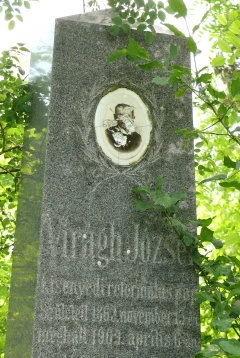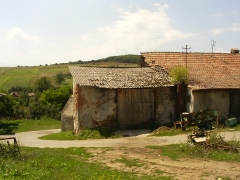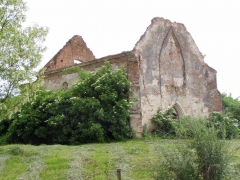Valea Secaselor: Sângătin (Kisenyed,Kleinenyed) Păuca (Pókafalva, Törnen, Pockendorf), Vingard (Vingárd, Weingartskirchen)
Păuca (Pókafalva, Törnen, Pockendorf)
Păuca (Pókafalva) is situated in Sibiu (Szeben) county, at east from Vingard, on road 107B. In the first written document it was mentioned in 127 as Pokafalua. Further variants of the name: de Duabus Turribus (1309), Pouka Cheuturn (1313), Poka (1328), de Buabus Turribus (1332), Pókafalva (1418), Czwen Turren (1478), Dörna (1484). The history of the reformed church’s building began in 1416, when László, the provost of Sibiu built a convent for the Pauline order. This convent was mentioned in 1418. The church was consecrated in honor of the Virgin Mary. After many attempts, with the permission of Pope Alexander VI. In this building, abandoned by the Paulins, the Franciscans found a home. In 1533, because of the Turkish attack the Franciscans run away. In 1560 Zsigmond János gave the convent to István Kemény and Miklós Balázs. The mixed Hungarian and Saxon locals during the Reformation were first Lutherans. The Saxons remained Lutherans, the Hungarians became Reformed. The catholic church was used by the Lutherans, and the church of the Pauline convent by the reformed followers.
The frame of the reformed church is from the 16
th century; from the renaissance period. In the 18
th century the settlement was a mother-church. At the beginning of the 20
th century still remained that, but during the century it lost its economic fields and its flock. In 2011 only the ruins of the church and the church’s garden remained. In 2010, with the leadership of József Ötvös and András Gudor, the interior of the church was cleaned.
Vingard (Vingárd, Weingartskirchen)
Vingard (Vingárd) village is situated at 25 km from Alba Iulia, at south-east, between 5-600 meter hills, in the valley of Secas (Székás Székes). The name of the village first appeared mentioned in documents in 1309 with the German name of Weingarten, which means vineyard. Other variants of the name: in 1309 Wyngartkyrchen, in 1329 Wyngarthkeerh, in 1332 Wynkarthkyr, in 1345 Vengherskirch (alio nomine Guga), in 1425 Vingard, later Chybay, Weyngarth, Wyngarth, castrum Wyngarth, in 1528 Vengertzkirg. In 1309 it had a catholic church, testified by the ‘kirchen’ word from the name of the settlement. The priest then was Bartholomew, who appeared in the trial with the Cathedral Chapter and the Clergy. The church and the Hungarian and the Saxon inhabitants in the Middle Ages became reformed. In the 15th century a new church was built. The late Gothic stylish, tower less building it remained almost in the same shape till nowadays (it reminds of the Franciscan church from Teius and the reformed church from Cluj Napoca). A Gothic gate leads to the sacristy. The original vault of the church was replaced in the 18th century with a Baroque vault engraved with the coat of arms of the Geréb family representing a crowned lion. It was also engraved the coat of arms of the Hunyadi family, the raven with the ring, and also the coats of arms of Szapolyai and Szilágyi families. The 16th century tombstones of Katalin Keserű and another member of the Keserű family can be seen in front of the altar; on the south wall there is the sepulchre from 1887 of countess Borbála Vargyasi Kendeffy. Under the choir there is a tomb, which collapsed in 1952. The church is 28 meters long, of which the nave is 9.25, the choir 7.75 meters, and the two are separated by triumphal arch. On the western side there is a stone panel with the coat of arms of the Kacsics family, and an inscription about the founder: „Hoc opus fecit fieri Magnificus Johannes Geréb de Vingart Anno D. MCCCCLXI./ 1461.” (The Christening Basin from the foundation year still exists.) At the moment the church is used by Lutherans. The reformed church is on the eastern part of the settlement. Next to it there is the mansion of the manor of the Reformed College from Aiud. The church of the Congregation, the stable, the parish supported by the Gábor Bethlen College went into ruins; the registers have disappeared. The school closed up, only 2-3 persons went to church, in 1934 the agricultural lands were taken by the state, the parish and the roof of the stable were in a bad shape. According to the records from August 5, 1595, the church was unusable, the side buildings have disappeared. The church became a granary, the state wouldn’t give the parish back. At the moment the church is in the possession of the Town Council, and the Congregation is under the leadership of the Reformed Church from Alba Iulia.
Sângătin (Kisenyed, Kleinenyed)
In 1292 a Saxon inhabitant, Arnold from Apoldu de Jos (Alsó Apold) owned Sangatin (Kisenyed). This settlement with a Hungarian name was then a saxon possession Sangatin (Kisenyed) had mixed inhabitants: Romanians, Hungarians and Saxons. Its Church built in Roman style was rebuilt in Gothic period. Originally the shrine didn’t have stanchions, therefore it is questioned if it had a vault ceiling or not. Sangatin was in the possession of the famous Bolyai family too. In the 18th century the Reformed Church had only a few members and one tabernacle. In 1754 Mihály Benedek was its reverend. In the 18th century it had serious economical problems. There are known a few reverends from the 18th century: between 1774-1777 Sámuel Filep from Alba Iulia became secondary reverend in Drasov (Drassó) and Sangatin (Kisenyed), and Count GergelyBethlen’s private teacher. From 1777 to 1779 Mihály Benedek was the community’s reverend, who later served in Taga (Cege). After the events from Mihalt (Alba county) the revolted tribune coming back from Sibiu, under the leadership of Dobra, starts the disarmament of the Hungarians. Singatin was the first victim of the Transylvanian Civil War on 14 October 1848: 170 Hungarians died. Their lands were taken by the Romanians as a result of the Romanian land reform. In 1925 the Hungarian school was closed; the number of the Hungarian reformed inhabitants in 1928 was 69. It was then that they mentioned: “the church is cracked and the interior is such a bad shape that it cannot be used. A commission will check it under the intention of demolation. The new parochial house is in a pretty good shape. One of its room is used as a tabernacle in consideration to the small number of members. The old parochial house and the basement below are subsided, one of his windows is broken – it is completely useless.” In the trial with the Romanian State upon the recognition and transcription of the parcel bought from the Hungarian state for the reformed church, the last one had a tragic fate. The parcel for the new parish house was bought by the reformed church between 1911-1914 from the Hungarian Treasury for the price of 400,60 crowns, during Jenő’s Balogh priesthood. The new parish house was built on this parcel, and they didn’t built on the one received from the Romanian State, although they payed for it. the new Romanian authorities, making a reference to the Peace Treaty from Trianon, took the new parish house from the priest, János Hideg, in 1926. the tortured Reformed Church began a long and difficult trial. The situation was sharpened by the fact that the bricks and stones from the ruined church tower were taken, without the consent of the church, by the Romanian Town Council. The trustee of the church, József Virágh, who made a complain about this, was taken to the army, János Hideg, the reverend was taken to a concentration camp, where, on 17 on 18 October 1940, died; the demolition of the church was told as legal. At present Singatin (Kisenyed) doesn’t have reformed members.







